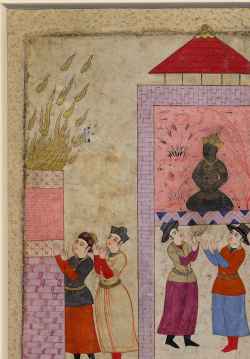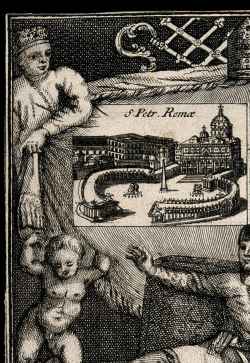Keyword: Islam – Image Gallery
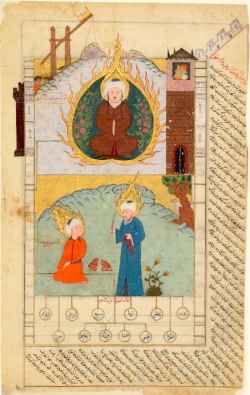
The sacrifice of Isaac. The Prophet Ibrahim (Abraham) surviving the furnace (above), and preparing to sacrifice his son Ism'il (below), from The Cream of Histories (Zubdat al-tawarikh) by Sayyid Luqman-i 'Ashuri (1585)
from: Sayyid Luqman-i Ashur, Zubdat al-tawarikh, Istanbul, Turkey
Sayyid Luqman-i Ashur, Zubdat al-tawarikh, detached folio, Chester Beatty Library, Dublin
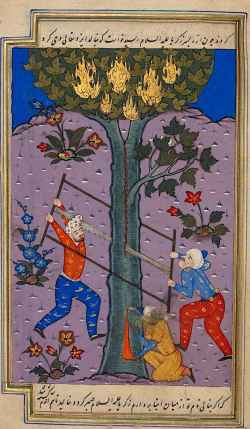
Martyrdom of the prophet Zakarīyā (Zechariah) (XVI)
from: Nīšāpūrī, Isḥāq Ibn-Ibrāhīm: Qiṣaṣ al-anbiyāʾ
Staatsbibliothek zu Berlin, Diez A fol. 3

Santiago Matamoros
Capilla de San Juan Bautista y Santiago, Catedral de Burgos
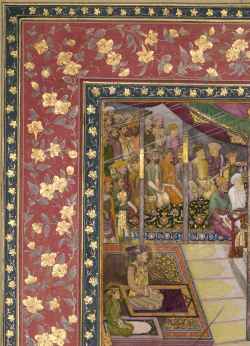
Emperor Jahangir and Prince Khurram at the gathering for the Feast of the Sacrifice (1615-1625)
from: India
Staatliche Museen zu Berlin, Museum für Islamische Kunst
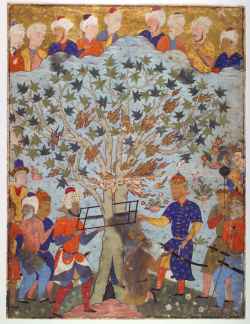
The story of the prophet Zakariya (a conflation of Zacharias, the father of John the Baptist, and the Old Testament prophet Zachariah), who according to Muslim legend died a martyr's death. Escaping his pursuers by hiding in a tree that miraculously opened to admit him, Zakariya was betrayed by Iblis, the devil, who pointed out the hem of the prophet's cloak protruding from the trunk. The devil's forces sawed the tree apart and with it Zakariya, whose saintly aura is shown as flames bursting among the leaves. (1550-1560)
from: from a dispersed copy of the Falnama (Book of Omens)
Worcester Art Museum
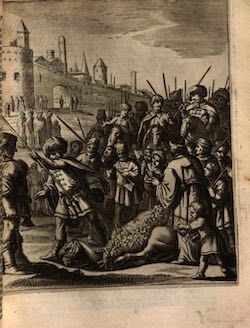
Sacrifice of the Camel (1666)
from: Della Valle, Pietro, De volkome beschryving der voortreffelijke reizen van de deurluchtige reisiger Pietro della Valle, edelman van Romen, in veel voorname gewesten des werrelts, sedert het jaer 1615, tot in 't jaar 1626 gedaan. Amsterdam, Abraham Wolfgang, 1666, vol. 1, pag. 128
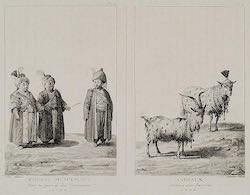
Goat and she-goat, turned to right, adorned for sacrifice (1626-1704)
from: Ohsson, Ignace Mouradja d', Tableau général de l'Empire othoman, Paris, Didot, 1787-1820, vol. 2
Wikimedia
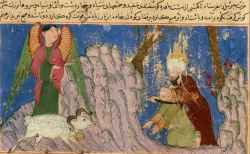
The Sacrifice of Isaac [1425]
from: Hafiz Abru, Majma` al-tavarikh, Sacrifice of Ismāʿīl, Walters Manuscript W.676Aa [from Istanbul]
The Walters Art Museum, Baltimore, Maryland
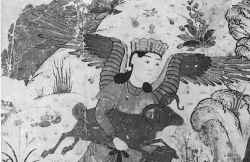
The Sacrifice of Isaac (1430)
from: Ms Hazine 2153, fol. 119
Istanbul, Topkapi Palace Museum, Hazine 2153, fol. 119
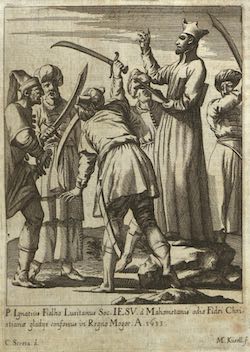
Ignatius Fialho, missionary in the Maghul empire, surrounded by Muslims woth swords (1675)
from: Tanner, Mathias, Societas Iesu usque ad sanguinis et vitae profusionem militans, Typis Universitatis Carolo-Ferdinandeae in Collegio Societatis Jesu ad S. Clementem, Prague 1675, p. 342
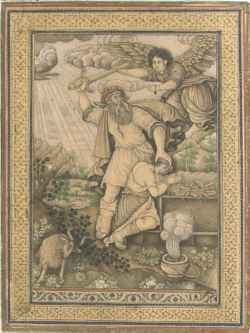
The Sacrifice of Isaac
Christie's, London
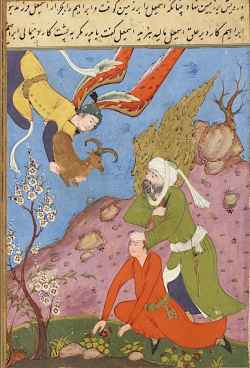
Abraham's Sacrifice (1595)
from: Histoire du Coran ou Histoire des prophètes et des rois passés. Qisas al-anbiyyâ [Supplément Persan 1313, fol. 40]
Bibliothèque nationale de France, Paris
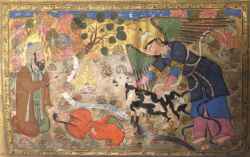
The Sacrifice of Isaac
from: From a late 16C copy of Jami’s Yusuf Zulaikha (IO Islamic 737)
London, British Library, IO Islamic 737

The Sacrifice of Isaac (16th)
from: Qiṣaṣ al-anbiyāʾ, Nīšāpūrī, Isḥāq Ibn-Ibrāhīm
Staatsbibliothek zu Berlin, Diez A fol. 3
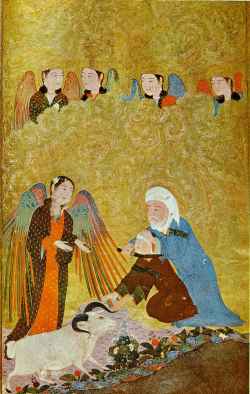
The Sacrifice of Isaac (Persia, Shiraz, Timurid period) (1410-1411)
from: Miniature from the Anthology of Sultan Iskandar (Persia, Shiraz)
Gulbenkian Museum, Lisbon

A mountain city with multistoried hill architecture. Outside the gates on the right is a Saivite shrine with a lingum covered by floral offerings to which a goat is led, probably for sacrifice. (17th)
from: Unidentified Hindu chronicle of a King
Metropolitan Museum, New York
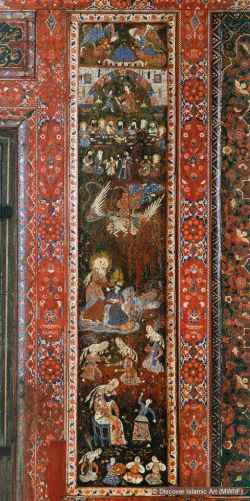
The Sacrifice of Isaac. A Christian citizen in Aleppo commissioned the painted panels of the walls of the entrance room in his house. Wood, multi-layered painting (1601-1603)
from: Aleppo
Museum of Islamic Art at the Pergamon Museum Source: [https://islamicart.museumwnf.org/database_item.php?id=object;ISL;de;Mus01;39;en&pageD=N&cp]
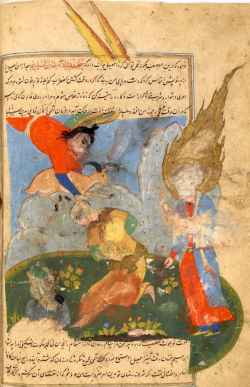
Abraham's Sacrifice (1600?-1650?)
from: Mîr Hwând, Rawzat al-safâ (Le lieu de repos des Purs) [Suppl. Persan 1567, fol. 50v]
BNF
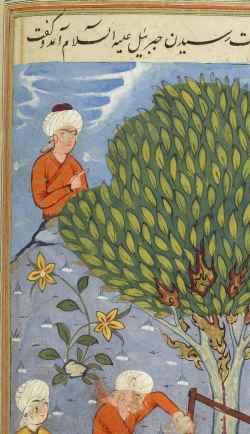
Martyrdom of Zakariya (XVI)
from: ishâq nishâbûrî, qisas-i qur'ân. [Qazvin, Iran]
Paris, BnF, Persan 54, fol. 144v

The Sacrifice of Isaac [1581]
from: Ishâq al-Nishâpûrî, Histoire du Coran ou Histoires des prophètes et des rois du passé. Qesas al-anbiyâ [Persan 54, fol. 32v]
Paris, BnF, ms Persan 54 fol. 32v
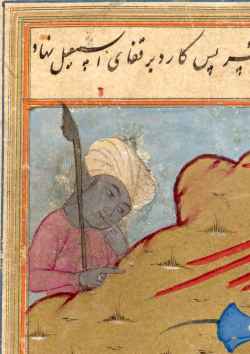
Ibrâhîm [Abraham] holding a knife is about to sacrifice his son Ismâ'îl (Ishmael) who kneels before him (1580)
from: Qisas al-Anbiyâ [Qazvin?]
The New York Public Library, Spencer Coll. Persian MS. 46

The Martyrdom of Zakarîyâ (Zacharias), the father of John the Baptist, who is killed when the tree in which he is hiding is sawn in two (c. 1580)
from: Nīsābūrī, Abū Isḥāq Ibrāhīm ibn Manṣūr, Qisas al-Anbiyâ [Qazvin?]
The New York Public Library, Spencer Coll. Persian MS. 46, fol. 144
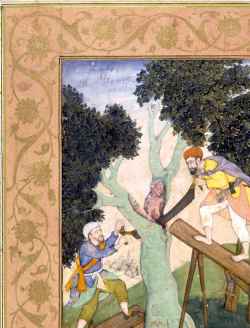
The martyrdom of the prophet Zakariya, who, taking refuge in a tree, was sawn in half by two men. (1605 - 1610)
from: This album of 104 folios known as the Clive Album
London, V&A Museum
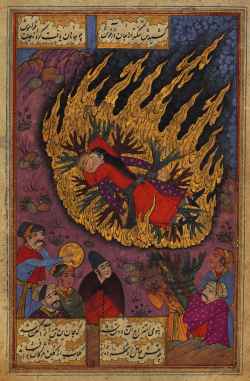
Satī, from a Sūz u Gudāz manuscript. The union of the couple on the pyre (1657)
from: Sūz u Gudāz ms, Iran, Walters Manuscript W. 649, fol. 19b (Burning and Melting)
The Walters Art Museum, Baltimore, Maryland
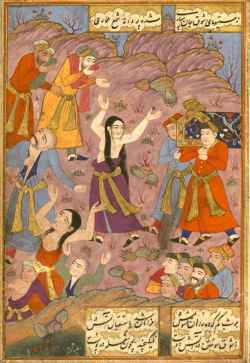
the young Hindu woman accompanies her bridegroom's coffin to the funeral pyre and decides to commit sati (1657)
from: Walters manuscript W.649 (Burning and Melting)
The Walters Art Museum
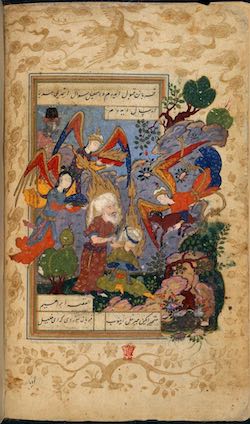
Ibrahim about to sacrifice Ismail. Cebrail (Gabriel) stands nearby holding the ram. (Late 16th/Early 17th)
from: A miniature painting from a manuscript of Hadikat us-suada, a history of the holy martyrs of the Prophet's family [Ms Or. 12009, fol.19v]
British Library, London [from Turkey]
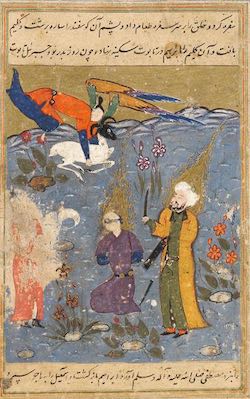
Ibrahim Preparing to Sacrifice Isaac (17th)
from: Ishaq b. Ibrahim al-Nayshaburi, Qisas al-Anbiya (Tales of the Prophets), ms, fol. 43 Turkey
Harvard Art Museums/Arthur M. Sackler Museum, The Edwin Binney, 3rd Collection of Turkish Art at the Harvard Art Museums Object Number 1985.275.43
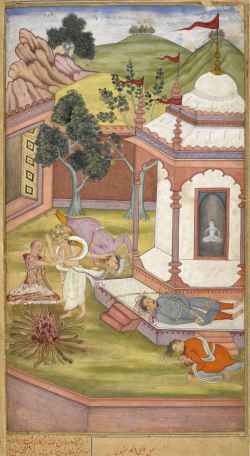
Candrahasa sacrifices himself cutting off pieces of his own flesh and putting them on the fire [1598]
from: Razmnāmah by Abhinanda, India (The last volume of the Persian translation of the Mahābhārata commissioned in 990 by Akbar)
London, British Library, Or 12076 folio: 90v
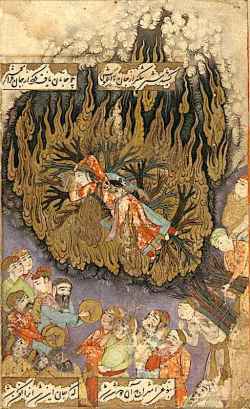
Satī. The bride immolates herself on the funeral pyre (1657)
from: Isfahan, Iran
The Israel Museum, Jerusalem

Zacharias sawn in half in a tree (1570-1580)
from: Qazwin, Iran
Dallas Museum of Art (Keir Collection), Dallas K.1.2014.1166 (III.278) folio: 231r
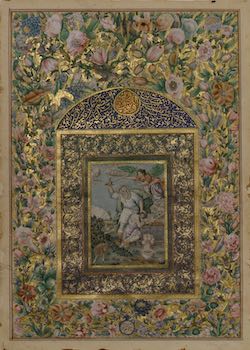
Abraham's Sacrifice (XVII)
Metropolitan Museum, New York
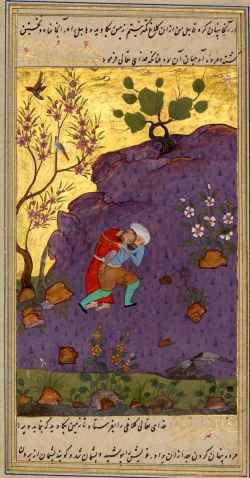
Qābil (Cain) and the dead Hābil (Abel) (XVI)
from: Nīšāpūrī, Isḥāq Ibn-Ibrāhīm: Qiṣaṣ al-anbiyāʾ
Staatsbibliothek zu Berlin, Diez A fol. 3

